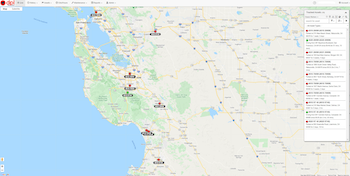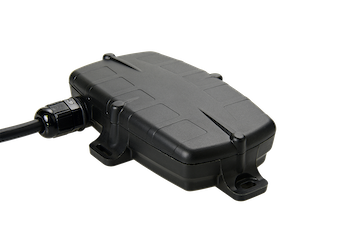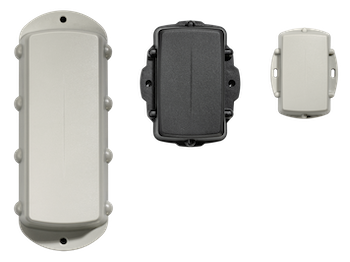Build Your Business -- Lock down your assets
GPS and telematics technology: The next evolution in theft protection.
by Tony Nicoletti
What if you could post a watchman on every asset you own, wherever it goes, 24 hours a day? What if you could shut down a stolen asset from 100 miles away? With telematics and tracking, now you can.
 |
|
Using a computer or app, rental houses can see the location of all their assets at any time as well as activate recovery mode to track them down. |
 |
|
AssetCommand Max, a hardwired device by DPL Telematics, offers driver ID and remote disable capabilities. |
 |
| Using off-the-shelf batteries and no wiring, the portable AssetView series by DPL Telematics is small enough to track rental deep fryers and stump grinders, among other revenue-generating assets. |
When it comes to protecting your valuable equipment, trailers and trucks, a dual strategy of prevention and recovery is required. Unfortunately, companies wait until something is stolen before implementing a theft protection plan.
With industry losses exceeding $1 billion annually in the United States and further exacerbated by the COVID-19 pandemic, equipment owners are turning to technology to curb theft issues. One customer has successfully recovered more than 30 stolen skid steer loaders since implementing GPS tracking in February 2020.
GPS tracking, one component of the broader technology named telemetry, is quickly becoming the innovative solution of choice.
Many equipment owners are already a evaluating telemetry systems on the merits of its productivity enhancing, service management and diagnostic capabilities for off-road equipment. The technology has been around even longer for trucks, yielding benefits such as fuel savings, increased driver accountability and extended vehicle life. Theft protection is a bonus, which any savvy fleet manager should include in their assessment of this technology.
To better understand how to combat theft with GPS and asset tracking, one must first understand why it is so easy to steal equipment:
Easy access. Because equipment is parked on the side of the road or behind a chain link fence, all the crooks have to do is hop in and drive off. Although chain link fences once were a sufficient deterrent, thieves now simply jump over them, drive the machine through them and load the stolen equipment in the street. For trucks, theft occurs in minutes with a quick break in and hotwire.
Delay in discovery. Equipment can sit for days at a time without anyone touching it. Thieves are smart and often steal equipment on Friday night or over a weekend, knowing that no one will be back to the job site until Monday morning. Because trucks are an integral part of transportation, their theft typically comes to light within a few hours of their disappearance.
Difficulty in recovery. Stolen equipment is easily moved out of the country or resold to an unsuspecting buyer yet kept whole. A thief’s modus operandi with trucks, especially service trucks, is to loot the vehicle for tools and parts. Trucks have a higher recovery rate but are often found abandoned and stripped. Stolen trucks are sometimes used to commit other crimes, used as getaway cars or to transport contraband.
The crooks can easily get to your assets, start them and get a significant head start. The deck is clearly stacked in the thieves’ favor, but now equipment owners have an opportunity to swing the advantage to them with asset tracking and telematics.
Locking it down
Equipment theft typically occurs after hours or on weekends when witnesses are less likely, so an asset tracking unit can set up a curfew and/or geofence on equipment and trucks. The telematics solution can send a text to your cell phone or message your email if someone tries to start the asset or move it during off-hours. Additionally, geofences will trigger alerts if the asset goes out of or into an invisible boundary, such as a machine leaving the yard unexpectantly at 2 a.m.
Another key benefit of asset tracking is it allows equipment owners to remotely disable any asset at any time, from any internet-connected device. This feature is also useful for handling non-paying customers, so like the utilities, rental centers can shut the rental off if the renter’s account is not current.
A telematics system can also require the driver to enter an identification number to start the asset with a key fob, RFID card or keypad. The identification number is assigned to a driver or operator and without it, the asset will not start. This deters theft and also prevents unqualified operators from starting it, which is also a safety and liability risk.
Eyes in the sky
From a recovery standpoint, GPS empowers the equipment owner to find his or her asset anytime from an internet-connected computer. Simply login, then view the most current address and mapped location. Another important-GPS based feature is recovery mode, which remotely instructs the unit to send out a location more frequently, such as every 30 seconds. This creates a bread crumb trail. which allows police to follow the dots to the stolen asset. Most GPS systems will offer a satellite image of the asset’s location, which is necessary because stolen assets usually end up well off the beaten path. One North Carolina rental house located one of its missing rentals in Texas, just 20 minutes from the Mexican border. They remotely activated recovery mode and using a map and satellite view, the owner informed the police exactly which wrecking yard’s tree line was hiding the stolen asset.
This one recovery yielded even more recoveries because that wrecking yard was a staging area for stolen equipment sourced from all over the country. They would strip the decals and identifying marks off in the Texas yard, then move the contraband across the Mexican border.
Taking it to the bank
If the peace of mind isn’t enough to encourage a rental center to protect its entire fleet, then the insurance savings will. As insurance rates continue to rise, a recent theft claim is sure to increase a rental center’s premium. With more than 50 percent of equipment losses due to theft, rental centers can cut their risk by that same percentage by using telematics technology. Talk with your insurance agent to see what they can offer; in many cases, at least the deductible is waived.
The costs of theft run much deeper than just replacing the stolen asset. Today, rental centers must factor in the long lead times to acquire a replacement, which also means months of lost revenue. There is also the time factor of working with the authorities as well as the paperwork for the theft and the insurance claim.
From time to time, the statement, “We don’t have a theft problem,” comes up when exploring telematics. The current theft trend drives home the unfortunate reality that every rental house has a theft problem; some just don’t know it yet.
Tony Nicoletti is the vice president of business development for DPL Telematics, a leading provider of advanced asset monitoring and telemetry technologies for the construction, rental, and oilfield industries. Contact him at tony@dpltel.com.
This article originally appeared in the September-October 2021 issue of Pro Contractor Rentals. ©Urbain Communications LLC. All rights reserved.










